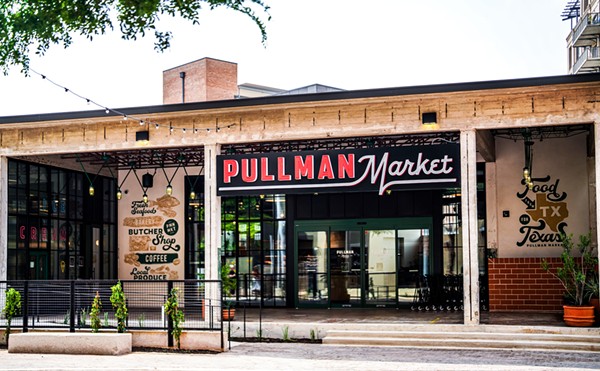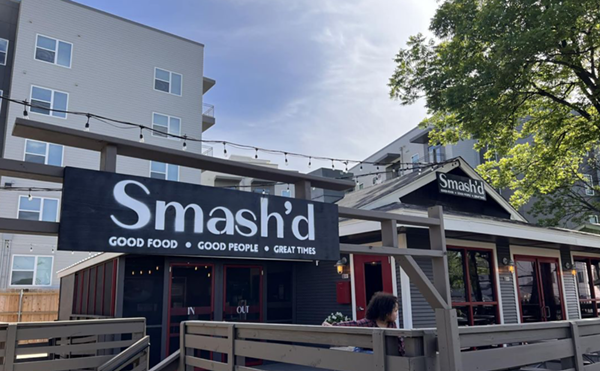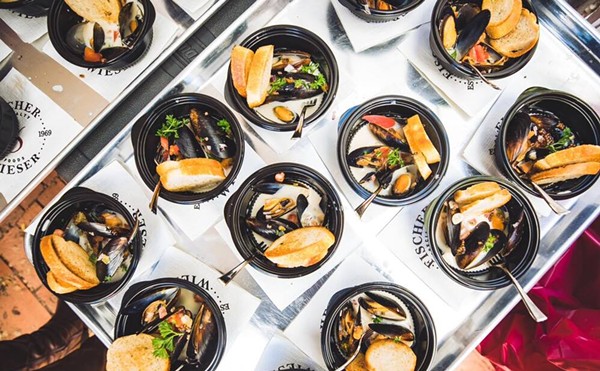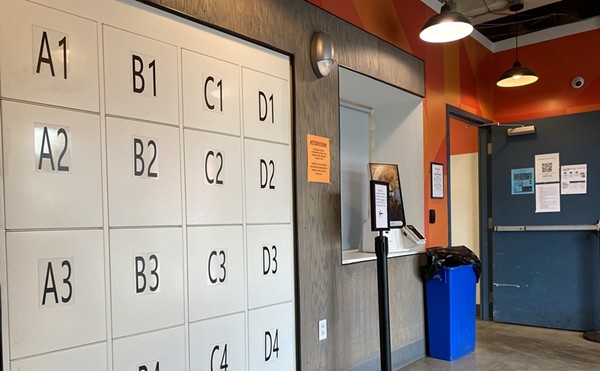This generalization will upset some, but when professional cooks and chefs talk about where their passion for food and cooking comes from, the first answer usually circles back to mom: “Mom was in the kitchen. Mom was a great cook. Mom was a wonderful hostess.”
This isn’t denying any props to house-husbands and dads who love to fire up the stove, but it does highlight a disconnect between sweet recollections of mama making supper and the reality of women working in commercial kitchens. Females working on a hotline tend to drop off as time goes on, just when their careers should be heating up.
When it comes to culinary school, the numbers are almost a balanced 50/50. In 2012, the Culinary Institute of America-Hyde Park had a 54-46 percent breakdown between male and female students. In San Antonio, St. Philip’s College’s culinary program included 60.9 percent female to 39.1 male students. According to chef-instructor Andrew Gutierrez, classes at the Art Institute of San Antonio are usually about 65 to 35 percent males to females.
So what happens to women between entering culinary school, making a name on the line and grabbing a chance at a coveted executive chef position?
Theories run the gamut. Hellish schedules, the physicality of the job and, yes, family planning, come into play.
Chef instructor at the CIA-San Antonio, Elizabeth Johnson-Kossick gave several reasons why so few women don the toque.
“The restaurant industry is not very flexible. It doesn’t lend itself to women being able to juggle family and professional abilities.”
She also points out the amount of work that goes into being in the kitchen, and maintains that some women might not be able to lift the large stock pots and heavy trays commonly found in large batch cookery. Don’t forget the hazing and the isolation of being the token female.
“There’s a healthy amount of discrimination, depending on the kitchen, some prefer more men—still there are kitchens where you find mostly women,” Johnson-Kossick said.
R-E-S-P-E-C-T
For the most part, finding executive female chefs in San Antonio was an ordeal. There isn’t a huge media presence surrounding local ladies of the kitchen just yet.
It takes some shoe leather, but these women are out there. Mosey your way down to Bohanan’s Prime Steaks and Seafood and you’ll find Heather Nanez, head chef at the downtown institution for more than 10 years.
Nanez first made her way into the food industry in the ’90s when she started bussing tables at the now-closed Fratelli’s as a way to earn some extra cash while at San Antonio College. Even though Nanez was trying to earn a degree in Radio, TV and Film, she became enamored with the “rock stars” running the kitchen.
Nanez worked her way up in a handful of kitchens before landing her latest gig at Bohanan’s, all while never taking a formal cooking class.
Now a member of Les Dames d’Escoffier International of San Antonio, an organization that promotes females in all areas of the culinary industry, at 46, Nanez has earned the respect of her peers and workers. But she says it takes thick skin to make it in the kitchen. She credits hers to having three brothers. “I get along with guys really easily,” she said.
Thick skin can only take you so far when you think of the amount of work running a kitchen requires. Nanez’s day-to-day schedule involves prepping for lunch, running service, going to meetings, menu planning for catering events, working with distributors and doing it all again for dinnertime.
“It’s tough to work in any kitchen.
It’s a rough job, it’s long hours, and if you’re trying to start a family, it’s hard on you. It’s a lot of dedication. You have to be in your kitchen 10-12 hours a day and it’s not an easy thing to do,” Nanez said.
She admits it’s rare to see females on the line and remembers hiring two female cooks in the past. She also mentions the tendency for females to work on the pantry line.
“(I think they’re) more inclined to measure and be more precise,” Nanez said during an interview at Bohanan’s, adding, “It’s not my thing. I’m making cookies right now and that’s a stretch for me.”
Many women choose to devote their talent to the pastry arts rather than other kitchen roles that traditionally lead to executive chef positions.
Some point to the artistic aspect of baking and the science behind breads. Others, like Cynthia De La Fuente, believe women are more detail-oriented and better multi-taskers.
De La Fuente, full-time pastry arts instructor at St. Philip’s College for more than a decade, spent some time in a commercial kitchen after receiving her degree from the school.
“I realized very quickly that I had to exert my position and boundaries right away. Other women didn’t last very long…they felt they were constantly being harassed,” De La Fuente said.
The solution she and her fellow instructors stress for their students is to be the consummate professional.
“Don’t give anybody a reason to think you’re of less quality. That’s what makes you promotable,” De La Fuente counseled.
Nanez wonders if gender is even that big an obstacle when it comes to females in commercial kitchens.
“I’ve never been a male in the kitchen, so I don’t know the other side. Some people might have had a hard time, but I’ve been fortunate not to,” Nanez insisted.
While Nanez, might not have encountered much flak on her way to being a head chef, there’s no denying the boys-club feel most cocinas possess.
Brooke Smith got her ass slapped at age 19 by a coworker at a restaurant she declines to name. After training under Mark Bliss, attending the New England Culinary Institute, and interning in prestigious restaurants in Portland, Ore. and Austin, Smith opened the kitchen at the Esquire Tavern as executive chef in 2011.
“You hear nightmares of sexual offenses all over town,” Smith said. “I think that if you’re a woman in the kitchen, the way you last is that you stand up for yourself and don’t take much bullshit from anybody.”
Smith dealt with her offender by turning around and letting the butt slapper know that wasn’t going to fly with her.
“Some women might not be able to take that, they might quit or might move into baking which is more female-dominant,” Smith said. “It’s not as hot, the hours are a little better. I admire people who can bake.”
Ass-grabbing aside, Smith admits running a kitchen isn’t for the meek.
“It’s a huge emotional load to hear what everyone’s going through, what everyone’s getting upset about. You have to manage all of that and keep yourself cool and collected,” Smith said.
At just over two years at the helm of the staff, Smith is still learning how to delegate, put procedures in place and look over a staff.
When asked about other female chefs, she mentions Caitlin Simmons, kitchen manager at Stella Public House and former chef at Auden’s Kitchen; when pressed with where women might go in the industry if not heading up a restaurant, she points to catering.
You Don’t Own Me
“You get to plan for it, you know what happens every night,” Smith said of one of the more popular paths for female chefs. “At restaurants, you’re going through shit, going through towels, dropping tongs. You’re so frantic you might not know if you’re going to make it through the night. Catering is a different beast. You know your numbers.”
Catering also allows more flexibility. Jennifer Dobbertin, who previously worked in nonprofit management, kind of fell into food. After living in Bangkok for several years, she returned to the States and wanted to replicate those authentic Asian flavors. Because she has no professional training, she hesitates to call herself a chef.
She worked in a kitchen briefly before realizing that being on a line wasn’t for her.
“I don’t have the energy for it. I started late and I have total respect for everyone in the kitchen that works as hard as they do…if I had started 10 years ago, it’d be a different story,”said Dobbertin.
She had some insight into industry life as a child. Her classically trained chef father launched his own eatery and Dobbertin was able to see how hard her parents worked, how much of a strain it put on her parent’s relationship and how grueling kitchen life can be.
Her brief commercial kitchen stint also gave Dobbertin a taste of what she called a “locker room” setting.
“It’s boys. It’s an extremely male-dominated environment, so I had to put my head down and get to work. I’m kind of a tomboy as well, so I can kind of join in a little bit, but it’s still tough,” Dobbertin said.
To pursue her newfound love of food, and not have to climb up an old-school kitchen hierarchy, Dobbertin started several culinary ventures: We Both Love Soup (which is on a summertime hiatus), Hot Mess Catering and Riff Raff Supper Club.
The advantages of catering are clear for Dobbertin who can plan menus in advance, take as many jobs as she wants and have more control over her hours and the people she employs.
“When you’re working the line, you don’t have control over rush, over how many people to expect or what to prep for. You’re making educated guesses,” Dobbertin said. “I might have control issues,” she admitted.
Fanny Valdez, 55, and daughter Jame Arias, 33, skipped the brick-and-mortar hot line and opened the food truck Sabor Colombiano on Wheels in 2011. With three summers under their belt, the mother-daughter team are setting their own schedules, working about five hours a day, four days a week and sticking with corporate lunches, events and catering.
“Jame’s pregnant so we still know what our priorities are,” Valdez said.
The pair has to drive the 36-foot RV to gigs, change propane tanks and load product into the truck for every event.
“A lot of people ask, ‘Who’s the boss? Who owns this?’ It’s very cool for us as women to be the ones in charge. We’re the boss, manager, operator, cook, cleaner—everything,” Arias said.
As founder of Southtown’s chili provider (aka the mobile Institute of Chili), Ana Fernandez doesn’t see a gender divide, if anything, being a female fit the image for her original concept she deemed a traditional way to make money in San Antonio, recalling the ladies who operated open-air chili stands in SA at the beginning of the 20th century. Also wary of self-designating as a chef, Fernandez gets a kick out of being among the minority in the “boy’s club.”
“I don’t think that’s a bad thing, I don’t feel excluded from the group,” Fernandez said. “I want to stick out.”
Valdez says the only disadvantage to being female proprietors and chef is when their 27-year-old RV breaks down on the road.
“We have insurance and a really nice mechanic,” she laughs.
Whitney Matthews, owner of the SpiceSea Gourmet truck, takes great pride in being able to service her loyal steed.
“The difference between when I started and now, is that people used to say, ‘Look at that little girl driving that truck around.’ Now when I go places, people call me chef, and I still turn around and I’m like ‘who are you talking about?’” said Matthews.
A graduate of the Virginia Military Institute and the Culinary Institute of America-Hyde Park, Matthews worked in several kitchens before opening her own truck. She cut her teeth under Bruce Auden at Biga on the Banks, worked at the CIA as a manager-in-training and later the CIA Bakery and finally at RoMo’s Café as sous chef for Rob Yoas.
“I firmly believe San Antonio is about 10 years behind in the culinary world and in a world accepting women as leaders [in the kitchen],” Matthews said. Yet, she’s a perfect example that it can be done.
“I liked the restaurant setting, I just didn’t like working for anyone else, I liked the adrenaline rush and it does translate onto the food truck,” Matthews said.
I’m Every Woman
Margeaux Alcorta, 26, sous chef at BIN 555 is another adrenaline junkie who jumped into the field after quitting her job and applying to Le Cordon Bleu in Las Vegas.
“You have to have some thick skin,” Alcorta said, echoing Nanez, “I worked with a great bunch of guys who took me under their wings and I wasn’t scared to be on the line. I wasn’t scared of the fire. I wanted to be thrown in the pit.”
For Alcorta, who’s dating Tre Trattoria sous chef Ancelmo Barrera, choosing between starting a family and running a restaurant won’t be a problem.
“I see Jason, who has four restaurants and the DUK Truck, and they mange to have a happy family. The kids will come in, we’ll make them pizza. It’s not an issue,” Alcorta said.
Alcorta is also trying to help her metaphorical sisters out by taking on female culinary students working as externs.
“Some culinary schools don’t prepare students for the real world,” Alcorta said of the air conditioned, highly functional classroom kitchens. “A lot of students come into their externships and they’re in a 500-square-foot line, it’s sweaty, [the] oven’s funny—it’s easy to get discouraged.”
Yes, there are 15-hour bad days when sleep-deprived cooks don’t get a chance to sit down or have a meal, and as Alcorta put it, students might hate their lives for the first two to three weeks on the job, but those extra man hours will pay off.
As San Antonio continues building its reputation as a culinary destiny (baby steps, folks), Johnson-Kossick and other Les Dames members are hoping to help make the scene that much more female-friendly.
“I see a real need in our industry for students to have a good role model… of female chefs handling stress, realities of the job and not mistreating themselves,” said Johnson-Kossick, who’s planning to host a fundraising dinner with Les Dames at NAO this fall to encourage co-mingling of established industry females and students. Johnson-Kossick, a single mom of two, hopes to build a sisterhood that champions female chefs.
She noted, “Because there are so few of us, it’s almost like we each have a social responsibility to be good mentors and make time and help guide other females. Be allies.”















